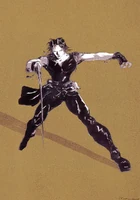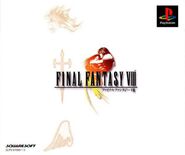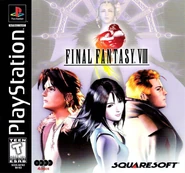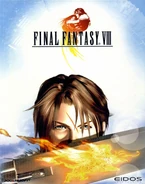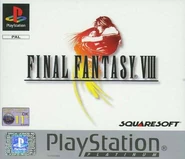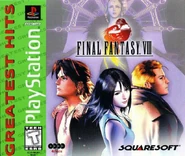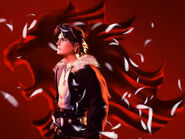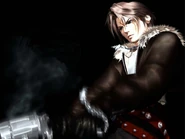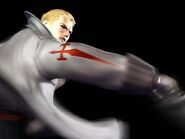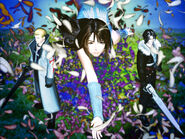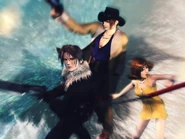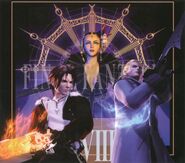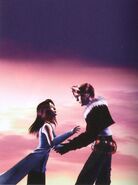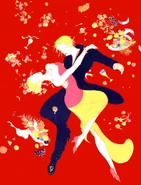Template:Sideicon
Template:Infobox CVG Final Fantasy VIII is the eighth installment in the Final Fantasy series. The game is the second Final Fantasy developed for both PlayStation and PC. It was made available as a PSOne Classic over the PlayStation Network in Japan on September 24, 2009, in North America on December 18, 2009 and in Europe on February 4, 2010.
Thirteen weeks after its release, Final Fantasy VIII earned more than $50 million from sales in the United States, making it the fastest selling Final Fantasy title at the time. Additionally, Final Fantasy VIII was voted the 22nd-best game of all time by readers of the Japanese magazine Famitsu. Final Fantasy VIII went on to become one of the best-selling games in the series; the game had shipped 8.15 million copies worldwide as of March 31, 2003.[1]
Final Fantasy VIII is a departure from many traditional series standards. It is the first Final Fantasy game to consistently use realistically proportioned characters, the first to feature a vocal piece as its theme music, and one of the only titles to deviate from the series' traditional means of increasing a character's power via leveling (although levels are not completely abandoned as they were in Final Fantasy II). In addition, it does not have a Magic Point-based system for spell-casting. Instead, magic is collected, drawn, and created from items, and is used to power up the characters via the junction system.
Gameplay
The gameplay differs from previous titles, the draw and junction systems being the most notable changes. Instead of leveling up to learn new spells and abilities via weapons or a job class, the player must draw the spells from enemies and draw points, hotspots scattered throughout the game containing random numbers of a specific spell, or create them from items. This eliminates the convention of magic points, but encourages players to hoard and conserve spells both for direct use and for junctioning them to different stats associated with Guardian Forces, who also hold the learning of new abilities.
Enemies are randomly encountered on the field. There are three members to a party, and unlike in previous entries to the series, Final Fantasy VIII doesn't do a distinction between front and back row and any party member can attack any target. Pressing the trigger button just as Squall is attacking an enemy has him deal an automatic critical hit.
Guardian Forces
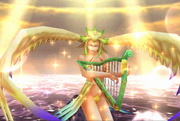
Siren, a Guardian Force.
Summoned monsters are known as Guardian Forces, often abbreviated to GFs. They require junctioning to characters to be used, as well as to utilize their inherent abilities. GFs take time to be summoned, and the time taken depends on the character/GF combination. When selected, the ATB gauge begins to run backwards and the character's name and HP are replaced by the GF's name and HP.
Similar to the aeons used later in Final Fantasy X, the GFs have HP and can take damage, shielding party members while being summoned. During the summon charge time, if the GF's HP reaches 0, they get knocked out and the summon is canceled. They can't be summoned until revived. When the GF's ATB gauge reaches zero, the GF is summoned and attacks in a similar fashion to Final Fantasy VII. If the summoned GF has learned the Boost ability, the player can attempt to boost the GF's attack power by up to 250%, but if the player fails to adequately boost the GF its attack power may actually be reduced rather than enhanced.
Guardian Forces gain Ability Points from battles to learn abilities. Each GF has unique abilities, though rare items allow the player to customize each GF's skillsets. Most abilities at least require junctioning the GF to a character, but some abilities also require junctioning to the character to take effect. Each GF has an ability that, once learned, can be junctioned as a battle command. The first two Guardian Forces are acquired at the beginning of the game. Other Guardian Forces can be acquired through sidequests, or by drawing them from a boss. Only three Guardian Forces are given automatically, the others are optional.
Junctioning
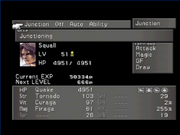
Squall's Junction screen.
The junction system is used for boosting character stats and to give elemental/status effects to weapons and armor. The player must junction a Guardian Force to enable the use of battle commands other than Attack. Boosting stats requires characters to obtain magic, by drawing spells from enemies and draw points and by refining from items with GF abilities.
The player can junction the spells to stats such as Strength, Vitality, Evasion and Hit-Rate. Which attributes can be customized depends on the junctioned Guardian Force(s). The Guardian Force can learn to unlock more statistics to junction magic to by earning AP in battle, and by the use of GF items.
Experience and leveling
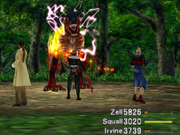
Squall casts Sleep in battle.
As with most games of the RPG genre, Experience Points are awarded following defeat of randomly encountered enemies. The system of leveling in Final Fantasy VIII is unique for two reasons: each playable character only requires 1,000 Experience Points to advance to the next level, whereas other games require progressively more points as levels are gained. The statistic increases granted by a level-up are minuscule, as major stat growth is relegated to the junction system.
The other feature is that enemies and bosses have no set level (although bosses have level caps); they increase in hit points, statistics, and abilities alongside the player party. Higher-level enemies are capable of inflicting and withstanding significantly more damage, and may have additional special attacks. They also possess better magic to draw and items to steal as their level rises. The benefit of this system is no matter where the player is in the storyline, there is a level of difficulty.
Furthermore, due to most locations being visited several times during the storyline and for sidequests, enemies encountered early will grow with the party and can still pose a threat later in the game. There are certain locations that are the exempt to this style of creature leveling, notably the Island Closest to Heaven and the Island Closest to Hell, where all creatures are at level 100 regardless of character level, and the Lunatic Pandora, where all creatures are at level 1 regardless of character level with Squall as party leader (more info here).
Limit Breaks
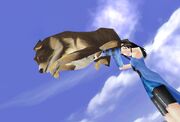
Angelo Cannon, Rinoa's initial Combine Limit Break.
The Limit Break system in Final Fantasy VIII is a more advanced version of the Desperation Attack system from Final Fantasy VI. Each character has a unique Limit Break based on their preferred fighting style. As a rule of thumb, while a character's HP remains below a certain point, Limit Breaks will become available.
One notable difference between this system and the Desperation Attack feature in Final Fantasy VI is that the player can opt to attack normally even if a Limit Break is currently available. Another is that the chance of a Limit Break becoming available will increase the lower the character's HP becomes, among other factors. Also, while Desperation Attacks could only be used once per battle, there are no limits to how often Limit Breaks can be performed, so long as the character remains in critical condition.
Several characters' Limit Break sequences are interactive, requiring the player's skill to reach its full damage potential; if performed correctly, these interactive Limit Breaks can be far more powerful than the non-interactive ones.
Field gameplay
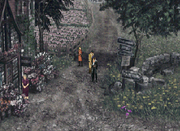
The party exploring Winhill.
Final Fantasy VIII doesn't have treasure chests, the player being rewarded with finding magazines, draw points, Triple Triad cards, and sometimes items from talking to NPCs instead. Triggering scenes in towns is not always linear: some optional scenes with NPCs only happen if the player returns to a screen after already having visited it previously.
Uniquely in the series until then, the distinction of dungeons and towns is somewhat blurred, there being rather few traditional dungeons, but town areas becoming infested with random encounters and with objectives to fulfill until the current crisis is resolved, and the area usually returns to being a town.
On the world map draw points are invisible. New to the series, the world map has safe areas from monsters if the player traverses on roads. Other world map transportation methods include renting cars which expend fuel, riding the train for which the party must buy a ticket, riding chocobos—timid creatures tamed in chocobo forests—and even controlling a mobile Garden that can cross oceans, and an airship that—in a feature introduced in Final Fantasy VIII—has auto-pilot.
Sidequests and minigames
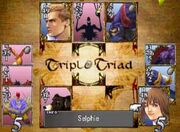
Triple Triad.
Final Fantasy VIII introduced a minigame that can be played whenever there are NPCs around; a trading card game, known as Triple Triad, that varies from a simple easy-to-play game to a complicated one. More rules and variations of other rules come into play depending on what area the player is playing in. To complicate things further, rules played within one area are carried to other areas, so the player will want to be careful what rules to pick up while playing.
Cards won from monsters or by playing NPCs can be turned into various items using Quezacotl's Card Mod ability, ranging from screws to items capable of being refined into the most powerful magics in the game. Cards can also be obtained by using Quezacotl's Card command to turn targeted monsters into cards.
There are sidequests relating to Triple Triad, and some sidequests reward the player with new Triple Triad cards. Card Club is a secretive club for expert Triple Triad players the player must impress to face the "Card Master King". Queen of Cards is a traveling card enthusiast who can commission new cards being made for the game, and affect the rules around the area she currently resides in.
Other quests include optional locations like Shumi Village and present-day Winhill, puzzles in chocobo forests, the mysterious UFO? encounters hinted at in Occult Fan magazines, and the shadow of the Obel Lake, among others.
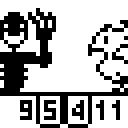
Chocobo World gameplay.
Chocobo World is a PocketStation game compatible with Final Fantasy VIII in which the player controls Boko the Chicobo, who embarks on a quest to find MiniMog, and is assisted by Moomba and Cactuar. As PocketStations were never released outside of Japan, international PlayStation owners could not play this game, but its connection to the main game was still programmed into every localization of Final Fantasy VIII, so it is possible to play the game by buying a PocketStation from Japan. Chocobo World was ported and included in the PC versions of Final Fantasy VIII, including the 2013 re-release, where Chocobo World is playable directly from the launcher after booting up Final Fantasy VIII.
Synopsis
Setting
Template:See Also
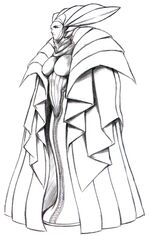
A sorceress.
The civilization is fragmented into small city-states and other autonomous groups. The two big nation states, Galbadia and Esthar, went to war two decades ago in a bid for world domination, both wanting to unite the autonomous groups under their banners. The war became known as the Sorceress War, named after the leader of Esthar, Sorceress Adel, a member of the seclusive rank of sorceresses, women able to wield magic. Sorceresses are both renowned and feared for their powers, and legends state they inherited their magic from the god Hyne who is said to have created the world and the people. No one is born a sorceress, but when a sorceress dies they pass on their sorceress power to someone else, and thus the exact numbers and identities of sorceresses in the world are unknown.
The Horizon Bridge connecting Galbadia and Esthar was abandoned when the hostilities began, apart from the middle station a group of engineers from Esthar made their home, and Galbadia conquered Timber. Before the war could escalate into full scale however, Esthar isolated itself and shut its borders with rumors circulating Adel had passed on her powers. Galbadia was left reigning the Galbadian continent, but the war had taken its toll on the populace and many children were left orphaned.
The world is still reeling from the after-effects of the war with Esthar remaining closed, and the mysterious radio interference filling all frequencies with noise, rendering the technology useless. This new phenomenon, whose origin could not be discerned, further isolated the different nations who can only transmit long-distance messages via physical cables which get frequently compromised by political strife and monsters.
Template:PseudoImage A new military power has risen to prominence: the Garden. Built 12 years ago, Balamb Garden trains paramilitary forces who can wield a power that imitates the power of a sorceress: Para-Magic via Guardian Forces. Based on technology developed in Esthar, Balamb Garden is the only organization in the world to use GFs whose use is rumored to have side effects, although Garden insists otherwise. Those who graduate from the academy become SeeDs who are contracted around the world as mercenaries and take on various missions.
Two "sister Gardens" were constricted in its wake, but although they co-operate and their students can often take classes in other Gardens or become transfer students, they do not train SeeDs, Trabia Garden serving as a military academy for the remote nation of Trabia, and Galbadia Garden focusing on weapon development—the only Garden to use guns—and training officers for the G-Army.
Characters
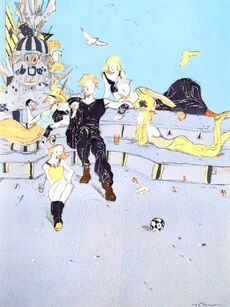
Artwork of the Final Fantasy VIII cast by Yoshitaka Amano.
Final Fantasy VIII has eleven playable characters, six of them used for the majority of the game, three used at certain interludes, and two other temporary characters.
- Squall Leonhart - The taciturn and reluctant hero. A lone wolf, he is known as a fearsome warrior in training, specializing in the rare gunblade. Though aloof and seemingly detached, he grows to appreciate his friends and love Rinoa, evolving into a model leader for his peers. His tagline is "...Whatever".
- Rinoa Heartilly - A beautiful and spirited young woman who abandoned a privileged lifestyle to join a resistance movement. Owns a faithful pet dog, Angelo.
- Quistis Trepe - A top-notch member of SeeD who serves as Squall's instructor. Though beautiful and popular, she is insecure. She overcomes this through her caring for Squall and her friends.
- Zell Dincht - A Balamb Garden student with unsurpassed martial arts skill who has a passion for hot dogs. In spite of his loud-mouthed attitude, Zell strives to be a model cadet.
- Selphie Tilmitt - A spunky young woman with a carefree spirit. Transferred from Trabia Garden, she tends to overcompensate her sad past with a happy disposition.
- Irvine Kinneas - An expert gunman and consummate ladies' man. Despite his facade, Irvine is determined, caring and sensitive man, and the only one who knows the hidden connection between all the members of the group.
- Temporarily playable characters
- Laguna Loire - A passionate man whose "pen is truly mightier than the sword". Despite disliking violence, he takes up arms in the face of injustice or when his loved ones are in peril.
- Kiros Seagill - A Galbadian soldier who wields katals in battle. An intellectual and cool person, he is Laguna's best friend and the voice of reason within the group of friends.
- Ward Zabac - A Galbadian soldier who wields a harpoon. Though intimidating at first glance, he is a caring individual and a most loyal friend to Laguna.
- Seifer Almasy - Squall's rival in Garden and a fellow gunblade-wielder. His dream is to become a sorceress's knight as per fabled legends.
- Sorceress Edea - A mysterious sorceress who surfaces as Galbadia's ally.
Story

Promotional artwork of Squall and Rinoa.
Squall graduates into SeeD, a mercenary hired out to various missions by Balamb Garden. His childhood dream fulfilled, Squall and his fellow rookie SeeDs are sent out to help the rebel group Forest Owls to free the occupied nation of Timber from Galbadia. The SeeDs' contact with the group is a girl called Rinoa, and protecting her—as she lacks combat experience—becomes part of the group's mission. On the way to meet with the Owls the party finds themselves in a dream world that depicts events from the past through the eyes of a Galbadian soldier named Laguna Loire, an event that is to become a recurring mystery along their journey.
The Owls fail to abduct the president of Galbadia as planned, but a rogue SeeD cadet Seifer takes him hostage to help Rinoa's cause. Squall's party joins his former teacher Quistis and they try to de-escalate the situation, but Sorceress Edea—whom the president was to announce as the nation's new ambassador—spirits Seifer away with her.
The group flees Timber with Rinoa and takes refuge in Galbadia Garden where they are hired to assassinate Edea, as the headmaster of G-Garden and the head of Galbadian Army conspire to save the nation from her influence. The assassination mission fails even with the help of G-Garden assassin Irvine, and they discover Seifer is now working for Edea as her "Sorceress's Knight".
Edea kills the president and usurps power in Galbadia and wants to destroy all Gardens besides the one she has now taken over: Galbadia Garden. Though Trabia Garden is demolished in a missile strike, Squall's party saves Balamb Garden by making it mobile, and they begin to use it as their base to travel the world. Squall is promoted the head of SeeD by Balamb Garden's founder Headmaster Cid who claims the SeeD's true purpose is to enter a fated battle against a sorceress and that Squall is the one who must take on the mission.
During their travels they learn Edea used to operate the orphanage from where Squall and his friends sans Rinoa grew up in. When Galbadia Garden led by Seifer and Edea launches an attack upon them, the SeeDs defeat Edea whose personality entirely changes, and Rinoa becomes comatose. Edea had been possessed by a sorceress from the future known as Ultimecia who seeks to unmake the world with a time compression spell.
Squall's quest to revive Rinoa from her coma leads him to discover the hidden nation of Esthar and that Rinoa has become a sorceress, having inherited Edea's sorceress power when they defeated her. Now having restored his childhood memories, Squall seeks out his "Sis" from the orphanage, Ellone, who has a mystical power to send a person's consciousness back in time to inhabit another person. She has been sending Squall back in time to inhabit Laguna for a reason she doesn't divulge, and Squall finally finds her from the Estharian space station. Squall has brought the comatose Rinoa with him, but Ultimecia possesses her to release Sorceress Adel from her spacebound tomb. Adel is Esthar's former dictator who was entombed in space to prevent her from passing on her sorceress power, but now Adel becomes Ultimecia's new vessel while Rinoa is left to die in space.
Squall saves Rinoa and the president of Esthar, Laguna, hires the SeeDs to fell Ultimecia. They learn Laguna looked after the orphaned Ellone when she was a child before they were separated and Ellone ended up in Edea's Orphanage. She has been wishing to reunite with Laguna and Squall, and thus sent Squall back in time in a dream, trying to change the course of events.
The SeeDs defeat Seifer and Adel, and with Ellone's help trigger the time compression and travel to the future where they defeat Ultimecia. As the timeline is fixed Squall goes too far back in time with the dying Ultimecia who passes on her sorceress power to the Edea of the past orphanage. Squall unknowingly sets his own destiny into motion by telling Edea to found the Garden, but with Rinoa's help he returns to his own time. Everyone heads to Balamb Garden to celebrate while Seifer returns to a normal life and Ellone has finally reunited with Laguna.
Themes
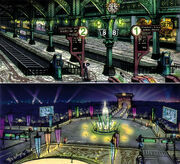
Deling City.
Final Fantasy VIII strives for thematic combination of fantasy and realism. To this end, Final Fantasy VIII was the first Final Fantasy game to have realistically proportioned characters—a departure from the super deformed designs used in the previous titles. The game locations were designed to resemble real world locations, rental cars and trains are used for in-game travel instead of fantasy-like vehicles, and to enhance the feeling of realism, motion capture technology was used to give the characters lifelike movements. Different nations and factions in Final Fantasy VIII have their own flags, their designs based on the country/group's history and culture.
Final Fantasy VIII marks the turn of the series toward a "young adult" genre, similar to the literary genre. It was designed to be bright and fresh in feel, an inversion of atmosphere from the previous two games, Final Fantasy VI and Final Fantasy VII. This decision manifests in the location designs in the use colors, such as the aquamarine and pink design of Balamb Garden or the overall design of Esthar, and even war-ravaged and poor locations, such as Trabia Garden, are displayed as sunny, vibrant and lively, as opposed to the shadowy oppressed slum atmosphere present in Final Fantasy VII.
The strive for light and bright feel, however, can conflict with the plot and the characters can appear indifferent and unable to react to tragic events with the seriousness one would expect them to exhibit; for example, after Rinoa has become comatose only Squall appears worried about her, whereas the others remain their cheerful selves, even when Rinoa and her condition is the topic of discussion. Still, one can identify a running theme within the game: dealing with the aftermath of war and tragedy and how people continue on despite of it.
The story focuses on Squall Leonhart, his love interest Rinoa Heartilly, and a small group of Squall's friends and rival. Whereas in Final Fantasy VI and Final Fantasy VII most characters have some playable scenario or side quests of their own, the characters in Squall's party are in more of a supportive role. To strengthen the main character's role the player has less control over his actions in the form of dialogue choices, and as a unique feature in the series, the player can see the main character's thoughts communicated via transparent text boxes.
The story is a coming of age one with a group of orphans originally trained to become mercenaries and fight for the sake of the world. School themes are heavy throughout, representing the carefree days of youth, as well as the struggles of growing up. Maturity, tradition and duty are emphasized; as Squall graduates his actions make him a role model and the succeeding leader of the next generation of SeeDs. Though each character starts as something different from what they end up becoming, they share a common background (except for Rinoa, whose background ties to Squall's), and its discovery becomes the turning point for the party's motivations. The bonds formed between the party get a central role to juxtapose with Squall's initial position as someone who relies on no one, and as he remains lost in the void of time compression's collapse Rinoa's love brings him back, transcending and breaking its hold on him.

Promotional art of Edea with the lyrics to "Liberi Fatali" talking of the end of childhood and the destiny the "fated children" would soon face.
A major theme is fate and predestination, as well as common Japanese themes of impermanence and inevitable loss (called mono no aware), however the latter themes have been somewhat toned down in the English version; during the final battle Ultimecia asks the party to reflect on their childhoods, but in the Japanese version she explains that childhood feelings fade away as time waits no one, making clinging onto them pointless. The story focuses on moving on from the past by showing the cast's childhoods' ends, and Ellone and Laguna's quests, but ultimately, although all things come to an end, the bonds between one another lead to new beginnings.
The game's antagonist, Ultimecia, is aware of the prophecy of how she would meet her end at the hands of the "legendary SeeD." To escape her fate she pursues time compression to make her the all-ruling god of the universe, but unknown to her time compression allows the "legendary SeeD" to reach her and destroy her. Garden and SeeD exist to train these "legendary SeeDs" to one day fight Ultimecia as per Edea's encounter with Squall in the game's ending, but Squall himself has no knowledge of his role until the end. In keeping with the theme of fate, the characters are often displaced through time in the roles of Laguna, Kiros and Ward, thus being able to "live" through past history, although never having the power to change what has been. Ellone (whose power allows the party to travel in time) touches this subject when she explains to Squall that although one can't change the course of events they can learn and grow through these experiences, bringing again the theme of the importance of growth, and learning from the past to achieve a brighter future.
Music
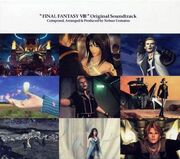
Cover of the Final Fantasy VIII: Original Soundtrack.
The game's soundtrack was Nobuo Uematsu's 23rd work for Square. Released on four compact discs by DigiCube in Japan, and by Square EA in North America, a special orchestral arrangement of selected tracks from the game (arranged by Shirō Hamaguchi) was released under the title FITHOS LUSEC WECOS VINOSEC: Final Fantasy VIII, and a collection of piano arrangements (performed by Shinko Ogata) was released under the title Piano Collections: Final Fantasy VIII.
The Final Fantasy VIII theme song, "Eyes on Me", which Uematsu wrote and produced for Hong Kong pop diva Faye Wong, sold a record-breaking 400,000 copies, placing it as the best-selling video game music disc in Japan until the release of "Hikari" by Hikaru Utada for Kingdom Hearts. It won "Song of the Year (Western Music)" at the 14th Annual Japan Gold Disc Awards in 1999, the first time a song from a video game ever won the honor.
Another popular song from the score is "Liberi Fatali," a Latin choral piece played during the game's intro. The sorceress theme "FITHOS LUSEC WECOS VINOSEC" was mixed with "Liberi Fatali" and played during the 2004 Summer Olympics in Athens during the women's synchronized swimming event.
The Black Mages, a band that arranged music from Final Fantasy video games into rock music, arranged five pieces from Final Fantasy VIII. These are "Force Your Way" from The Black Mages published in 2003, "The Man with the Machine Gun" and "Maybe I'm a Lion", from The Skies Above, published in 2004, and "The Extreme" and "Premonition" from Darkness and Starlight.
Development
| Yoshitaka Amano's renditions of Squall and Seifer, though not representative of their in game appearances, still show their visual similarities, most noticeably the scars across both character's faces, each given by the other in battle. | |
Final Fantasy VIII follows Final Fantasy VI and Final Fantasy VII in displaying a world with high technology, diverging from the more traditional medieval feel of the original titles. Final Fantasy VIII diverges further still by focusing the story on the characters over the world events. Character designer Tetsuya Nomura wanted the game to have a "school days" feel. Because Yoshinori Kitase already had a story in mind in which the main characters were the same age, the idea worked. Thus, they created the concept of military school-like academies in which the students would train to become mercenaries.
Further on, scenario writer Kazushige Nojima planned for the two playable parties featured in the game—Squall's present day group and Laguna's group of twenty years in the past—to contrast with one another. Leading to Laguna's group consisting of characters in their late twenties and have a lot of combat and teamwork experience, while Squall's party was young and inexperienced, and Squall himself not initially able to understand the value of friendship.
With Final Fantasy VII, the main protagonist (Cloud Strife) had a reserved nature that led Nojima to include scenarios in which the player can select Cloud's responses to certain situations and dialogue. With Final Fantasy VIII, Nojima wanted to give players actual insight into what the protagonist was thinking and feeling, even while the other characters remained uninformed. This led to Squall's "internal monologues" that appear in transparent text boxes throughout the game.
Kitase also expressed desire to give the game a deliberately foreign, largely European atmosphere. As part of this theme various designs were created using the style of ancient Egyptian and Greek architecture, as well as styles from the cities of France and idealized European societies seen in various artworks. Additionally, Kitase explained that the game's logo—Squall and Rinoa embracing—was inspired by the team's efforts to express emotion through body language. The team knew that the Rinoa and Squall scene was a big moment in the game, so they asked Yoshitaka Amano to draw this for the logo. Its red to yellow gradient reflects the sunset in the background of the moment Rinoa is falling toward Squall in the opening cinematic.[2]
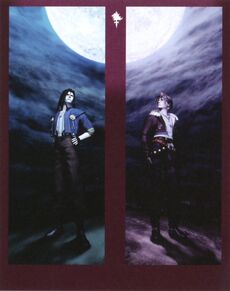
Squall Leonhart (right) and Laguna Loire.
This aim was also referred throughout the game; utilizing the game models to physically display their emotions and actions alongside the text boxes, as well as using updated CG full motion videos, which were far more advanced in detail than any Final Fantasy game that had come previously, to convey a kind of "silent movie" operatic atmosphere that didn't rely on words to convey their meaning.
Final Fantasy VIII is the first mainline title in the series to have "millennium silver" as the color of the menu and dialogue windows, since the color was popular in the late 90's as the world was about to enter a new millennium. This trend was also continued in Final Fantasy IX.
In terms of character artwork, Final Fantasy VIII reflected Nomura's preferred technique at the time, as opposed to Final Fantasy VII, which featured characters that "weren't really his style". The team had decided to use realistically proportioned characters; the higher level of full motion video technology would have otherwise created an inconsistency between the in-game graphics and the higher definition full motion video graphics. After Final Fantasy VII was finished, the development team thought players would feel something is off with the difference in proportion between the character models in battle and on the field, and so in Final Fantasy VIII the character proportions on the field and battle were kept the same.[3]
Nomura ended up altering each of the characters before they reached the final design stage, which required sacrificing his original intentions. For instance, he had originally wanted Seifer to be involved in a love triangle with Rinoa and Squall. As another example Quistis was originally going to be designed with a short skirt, but in the end was given a long skirt worn over pants. Rinoa was originally planned to wear a mini-skirt over shorts, but this led to a conflict as he wished to have at least one female lead wearing a skirt, and a compromise was made with Selphie's design: she was originally intended to be wearing overalls, but Nomura decided that her outfit should be something of a combination of the two, resulting in her overalls-skirt look.Lua error in Module:Cite at line 82: Could not find an entry in Module:Codename/data or Module:Sources matching this input.
A demo version of Final Fantasy VIII was released both for the PlayStation and the PC. One of the games that came with a demo was Brave Fencer Musashi.
As was common at the time, the localization team wouldn't get the actual files until months into development, and had to play and record the game itself to translate it off the screen to meet the looming deadline.[4]
Ports
PC version
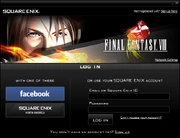
The game launcher of the 2013 re-release version.
Final Fantasy VIII was the second Final Fantasy game to be ported to a Windows platform. It was released on December 31, 1999 and re-released on December 5, 2013 for Steam.
The Steam version comes with several in-game enhancements, including a speed-up option to fast-forward through cutscenes and FMVs, as well as built-in cheats, such as "Battle assist", which makes battles almost impossible to lose.
Similar to Final Fantasy VII, the re-release version comes with the Magic Booster feature that allows the player to boost their characters' magics to 100. Achievements and cloud save data storage are also available. Windowed mode and high resolution displays (up to 1920x1080 @ 60Hz) are now supported. However, the game still uses the original midi songs from the 1999 version, rather than the PlayStation version music, unlike the 2012 re-released Final Fantasy VII that has received a musical update. Chocobo World is playable directly from the launcher after booting up Final Fantasy VIII.
System requirements
These system requirements are for the re-released version.
| Minimum | Recommended | |
|---|---|---|
| OS | Microsoft Windows XP/Vista/7/8 (32/64-bit) | Microsoft Windows Vista/7/8 (32/64-bit) |
| Processor | 1Core CPU 2GHz or faster | Intel® Core™2 Duo CPU 3GHz or faster |
| Memory | 1 GB RAM | 4 GB RAM |
| Graphics | DirectX 9.0c compatible card | NVIDIA GeForce 9600 GT or faster |
| Hard Drive | 4 GB available space | 4 GB available space |
| Sound Card | Integrated sound chip or more | Integrated sound chip or more |
| Others | DirectX 9.0c Square Enix account |
DirectX 9.0c Square Enix account |
Reception
At the time of its release Final Fantasy VIII received positive reviews and was commercially successful. After its North American release, Square Electronic Arts announced Final Fantasy VIII had sold a near unprecedented amount of units. The game was the number one selling video game in the United States across all video game software categories and remained on the top spot for three weeks.[5] Final Fantasy VIII grossed a total of more than $50 million in the 13 weeks to follow[6], making it the fastest-selling Final Fantasy title at the time. In Japan it sold more than 3.3 million units within the first month of release[7] and more than 6 million units were sold by the end of 1999. As of March 31, 2003, the game had shipped 8.15 million copies worldwide: 3.7 million in Japan and 4.45 million overseas.[1]
At the time, Final Fantasy VIII was generally viewed as a leap forward from Final Fantasy VII in terms of graphics, but many criticized the junction system as being overly complicated. Many critics praised the game's storyline, but some found it inconsistent in quality and that some plot twists were too sudden with not enough setting up beforehand, leaving players feeling indifferent, although many also praised the game's character development and called Final Fantasy VIII the pinnacle of the RPG genre. In 2002, IGN named Final Fantasy VIII the seventh best title for the PlayStation of all time, placing higher on the list than Final Fantasy VII.
Final Fantasy VIII was voted by Famitsu readers as the 22nd best game of all time in 2006 [8], and was named one of the 20 essential Japanese role-playing games by Gamasutra, stating "There's a lot that Final Fantasy VIII does wrong, but there's even more that it does right."[9]
Production credits
| Executive Producer | Hironobu Sakaguchi |
|---|---|
| Director | Yoshinori Kitase |
| Music | Nobuo Uematsu |
| Main Programmer | Ken Narita |
| Battle system Designer | Hiroyuki Itou |
| Character Design / Battle Visual Director | Tetsuya Nomura |
| Art Director | Yusuke Naora |
| Scenario Writer | Kazushige Nojima |
| Image Illustration | Yoshitaka Amano |
| Movie Director | Motonori Sakakibara |
| Movie Character Director | Hiroshi Kuwabara |
| Character Modeling Director | Tomohiro Kayano |
| Real‑Time Polygon Director | Akira Fujii |
| Battle Effect Director | Shintaro Takai |
| Motion Director | Tatsuya Kando |
| Card Game Director / Battle Camera Director | Takayoshi Nakazato |
| Lead Field Designer | Kazuyuki Ikumori, Kenzo Kanzaki, Yukio Natakani, Tetsuya Takahashi |
| Event Script Programmer | Shun Moriya |
| Battle Programmer | Hiroshi Harata, Kentarow Yasui |
| Event Director | Hiroki Chiba |
| Map Director | Takeshi Endo, Masaru Oka |
| World Map Director | Ikuya Dobashi |
| Sound Programmer | Minoru Akao |
| Sound Editor | Eiji Nakamura |
| General Manager | Yuji Shibata |
| Localization Director | Aiko Ito |
| Coordination Director | Tchie Tokoro |
| Localization Engineer | Richard Mark Honeywood |
| Marketing Managers | Akira Kaneko, Yasuhiro Suzuki |
| Assistant Manager | Tomomi Nishigaki |
| Localization Assistant | Yuichi Yamada |
| Square Soft, Inc. | |
| Localization Management | Masahiro Nakajima |
| Editors | Brian Bell, Richard Amtower IV |
| Associate Producer | Akihito Kozu |
| Square Electronic Arts L.L.C. | |
| Senior Customer Service Manager | Rick Thompson |
| Vice Chairman | Yoshihiro Maruyama |
| President | Jun Iwasaki |
| Special Thanks | Hideo Yotsuya, Lynn Biscoe, Beeline Group Inc., The Kenwood Group, Saatchi & Saatchi, C.H.E.N. PR |
Packaging artwork
Gallery
Template:See Also
Allusions
Final Fantasy VIII makes references to other Final Fantasy and Square games, to the number eight, Star Wars, 2001: A Space Odyssey, among others.
To date, Final Fantasy VIII has the highest number of Star Wars-inspired names, including Biggs and Wedge, Nida, Piet and Martine, who is named Dodonna in the Japanese version.
Trivia
- Final Fantasy VIII is the first game in the series that allows the player to name summons.
- Final Fantasy VIII is the first game in the series where Ramuh is not present as the Lightning-elemental summon. He is replaced by Quezacotl.
- Final Fantasy VIII is the first game in which all enemies have a death animation before they fade away.
- Final Fantasy VIII introduced pre-battle poses that begin before an enemy is engaged during an encounter, and the animation features the character(s) readying his or her weapon(s) leading into their main battle stance. It's the only game in the main series with this distinction.
- Final Fantasy VIII is the first Final Fantasy game to use motion capture technology from actors in motion capture suits.
- During the parade in Deling City, the masked dancers are performing the dance moves from Michael Jackson's "Thriller" music video.
- Final Fantasy VIII is parodied in the Dreamcast game Segagaga, where it is called Final Pharmacy VIII.

Final Fantasy VIII in Charlie's Angels.
- In the first Charlie's Angels movie, in the scene when Dylan approaches a house for clothes, there are two kids inside vigorously button mashing and moving while playing Final Fantasy VIII. Infamously for fans, both kids hold controllers even if the game has no two-player mode, and there are no sequences in which such button mashing would be required (except maybe for when using the boost mode for summons).
- The game's demo uses a track called "Raid on Dollet" for the Dollet invasion. The game's final version does not use that track and it was never released on any official soundtrack album. It is unknown why the track was scrapped, although a widespread theory is that it was removed for legal reasons due to heavy similarities with the song "Hummel Gets the Rockets", composed by Hans Zimmer from the movie The Rock.
See also
- Final Fantasy in Popular Culture
- Final Fantasy VIII Demo
- Final Fantasy VIII Technical Demo for the PS2
- Final Fantasy VIII Allusions
- Final Fantasy VIII Timeline
- Final Fantasy VIII Artworks
- Final Fantasy VIII Wallpapers
External Link
References
- ↑ 1.0 1.1 http://www.square-enix.com/jp/ir/e/explanatory/download/0404-200402090000-01.pdf#page=27
- ↑ http://finalfantasynews.com/2015/02/27/yusuke-naoras-smu-lecture-recap-featuring-new-final-fantasy-xv-concept-art
- ↑ Weekly Famitsu Issue no. 1224 Yoshinori Kitase Interview translated by TheLifestream.net
- ↑ EDGE #278 Tale of Tales Meet Alexander O Smith the translator who's brought some of Japan's biggest RPGs to the West p. 90
- ↑ Final Fantasy VIII Tops Videogame Charts
- ↑ FF8 Breaks Sales Records
- ↑ Final Fantasy VIII Is Out!
- ↑ Japan Votes on All Time Top 100
- ↑ A Japanese RPG Primer: The Essential 20
Template:FFVIII Template:25thcompl Template:Series

